Innovative Approaches to Wind Power Forecasting: A Comprehensive Review
Department of Electrical and Electronics Engineering, GJUS&T, Hisar (Haryana)
Priti Prabhakar
Department of Electrical and Electronics Engineering, GJUS&T, Hisar (Haryana)
Avnesh Verma
Department of Instrumentation(Formerly USIC), KU, Kurukshetra (Haryana)
Copyright © 2025 Krishan Kumar, Priti Prabhakar, Avnesh Verma. Published by Nan Yang Academy of Sciences Pte. Ltd.

This is an open access article under the Creative Commons Attribution 4.0 International License.
Abstract
Accurate wind power forecasting is essential for the seamless integration of wind energy into modern power systems, yet it remains a challenging task due to the inherent variability of wind, complex atmospheric dynamics, and the influence of local terrain. Traditional forecasting models often struggle to capture these complexities, particularly for short-term and intra-hour predictions. Machine learning (ML) methodologies have emerged as transformative tools for addressing these challenges. By leveraging large datasets and advanced algorithms, ML models can identify intricate patterns and significantly enhance prediction accuracy. Techniques such as deep learning, ensemble methods, and hybrid approaches integrate weather data with historical power output to improve spatial and temporal resolutions. Despite their promise, challenges like data quality, model interpretability, and computational demands require further research to fully optimize ML applications in wind power forecasting. The global transition toward smart grids, driven by the increasing penetration of renewable energy sources (RES), underscores the importance of reliable forecasting. Wind energy, as a key RES, plays a pivotal role in reducing greenhouse gas emissions and mitigating global warming. However, the stochastic nature of wind energy complicates power system analysis and management. Accurate forecasting is critical for enhancing power system security, supporting sustainability, and facilitating economic transactions in energy markets. This review examines ML-based methodologies for wind power forecasting, categorizing them into supervised, unsupervised, semi-supervised, and reinforcement learning techniques. It highlights their adaptability, scalability, and real-time capabilities while addressing challenges posed by noisy data, dynamic system behaviors, and complex grid configurations. Hybrid and ensemble models, in particular, demonstrate exceptional potential in overcoming these challenges. By identifying research gaps and emerging trends, this study provides strategic insights into developing innovative ML-driven forecasting methods, supporting effective grid management in an energy ecosystem increasingly dominated by RES.
Keywords: Wind power forecasting; Machine learning; Renewable energy; Smart grids; Hybrid models; Sustainability

